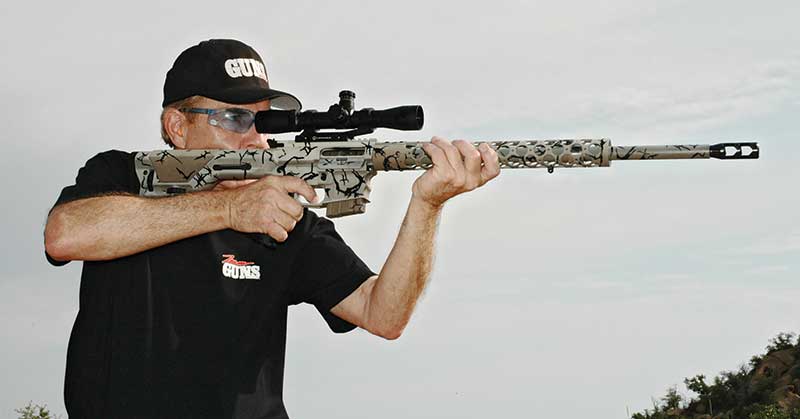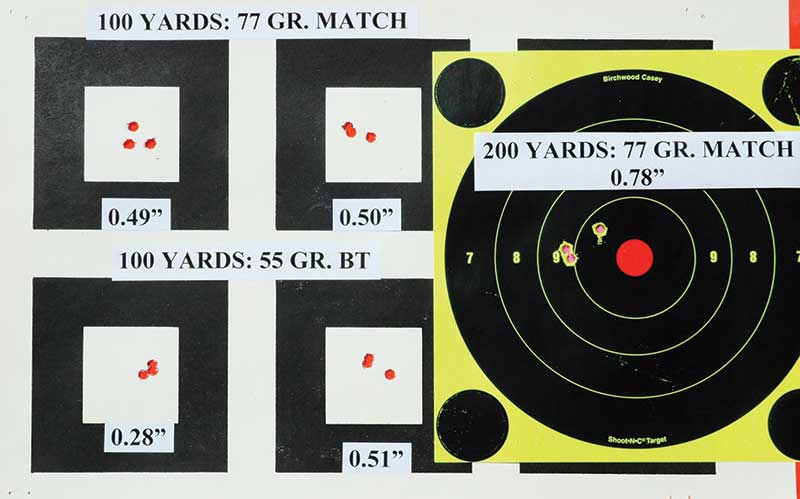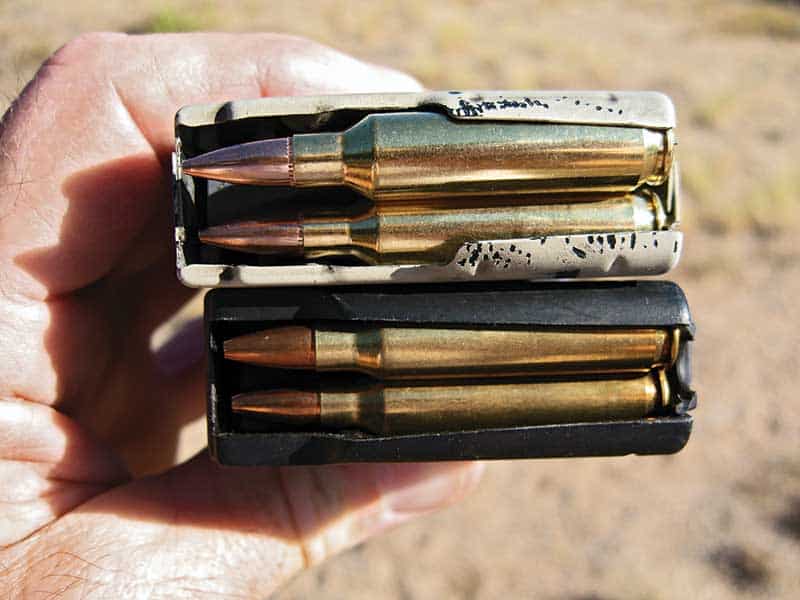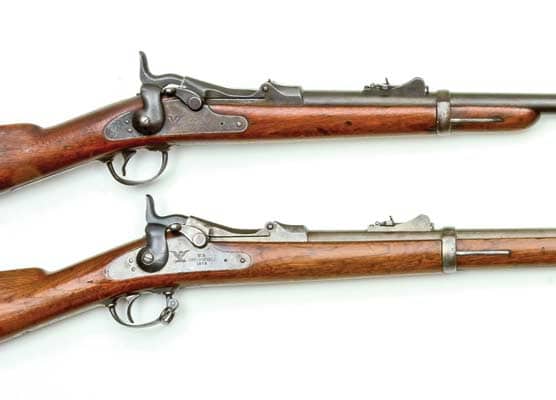Hot Like Phoenix
A Tackdriving New AR Helps The .22 Nosler Split The Difference Between The .223 And .22-250
A hot new varmint cartridge and a purpose-built AR to harness it. Making its debut at the SHOT Show, the .22 Nosler was a showstopper. After having introduced their proprietary .26, .28, .30 and .33 beltless magnums, the small end of the Nosler line needed filling out. And what better way to do it than with a powerful .224-caliber load compatible with the jillions of existing .223/5.56 AR platforms?
Shortly thereafter at the NRA Convention, Phoenix Weaponry showcased their spectacular, thoroughly custom-built AR chambered, no less, in .22 Nosler. On the range, rifle and cartridge proved a sensational combination. I predict you’ll be seeing a lot of AR’s fitted out with .22 Nosler uppers in the months and years ahead.
Developed by Mike Lake, Nosler’s Senior Manager of Engineering, Research and Development, the .22 Nosler is modern-looking case with a 30-degree shoulder, a minimum 0.020-inch taper from head to shoulder, a case length of 1.760, which is the length of the .223/5.56 case, and a rebated head measuring 0.378 designed to be compatible with existing .223/5.56 bolt faces.
There the .223/5.56 similarity ends. The .22 Nosler case is larger in diameter and has 20 percent more capacity than the .223/5.56. In fact, it requires a 6.8 Remington SPC magazine for smooth feeding in an AR. Average velocity gain over the .223/5.56 is 300 fps. That’s a significant gain in velocity, energy and downrange trajectory.
All major die manufacturers are turning out a variety of handloading tools for the .22 Nosler, from simple 2-die sets to the most sophisticated benchrest-type bushing dies. Nosler-prepped cases and loaded ammunition are readily available. And Nosler’s website has a complete book of reloading recipes for bullet weights ranging from 40 to 77 grains.
A few examples: Nosler lists a maximum velocity of 3,516 fps for the 55-grain bullet using CFE 223 power, 3,332 fps for the 62-grain pill pushed by RL-15, and 2,981 fps for the long, snaky 77-grain match bullet punched out by H380.
Some have called it an AR .22/250. No, a .22/250 it’s not (which bests the Nosler by 200 or 300 fps), but the .22 Nosler is an ingenious solution to maxing out velocities in a .223/5.56 platform.
The Company
Phoenix Weaponry, located in Longmont, Co., should be on every AR enthusiast’s radar. It’s one of the premier custom AR companies in the country. The staff is drawn from aerospace, optical, machining, manufacturing and gunsmithing fields. Their advanced machine shop is set up to prototype and manufacture AR parts and purpose-built AR’s. Phoenix Weaponry offers a selection of stock models ranging in price from $1,300 to $5,600, as well as custom parts, finishes, accessories and silencers.
The .22 Nosler heavy varmint rifle pictured here is an excellent example of the company’s capabilities. The strong suit of Phoenix Weaponry is the ability to conceive, design and manufacture an AR’s key components while still integrating the best components available from other manufacturers.
The upper receiver with its integral Picatinny rail is CNC machined in-house from a solid billet of 7075 T7 aluminum. A more subtle aspect of the design is what Phoenix Weaponry terms a “slick side” profile on the right side of the receiver where the forward assist and standard shell deflector have been eliminated. Looking more closely, you realize the usual stamped AR dust cover has been replaced by a proprietary machined one that’s unusually thick and when closed, virtually blending into the right-side contour of the receiver itself. The shelf at the rear of the dust cover mortise can serve as a case deflector.
For the bolt and bolt carrier, Phoenix Weaponry selected the technologically advanced assembly made by the Sharps Rifle Company. You might recall several years ago when Sharps developed their own “25-45” Sharps cartridge for the AR-15 capable of propelling an 87-grain, .25-caliber bullet to 3,000 fps. During the process Sharps engineers noticed two correctable defects in the standard AR bolt carrier, explaining, “The first being the rotational camming of the carrier during the unlocking portion of the operational cycle. The second being the canting of the bolt carrier group upon firing due to the gas pressure exerted to the gas key which naturally causes the front of the bolt carrier group to rise and the rear of the bolt carrier to be pressed downward during its rearward travel.”
As a result, the Sharps engineers designed a new Teflon-coated “Balanced Bolt Carrier” and bolt. Again looking for a superior component, Phoenix selected an Obermeyer 5R cut-rifled barrel with a heavy profile and 1:8-inch twist to wring out the best the .22 Nosler has to offer. The barrel has 5 grooves and lands offset from one another to minimize bullet deformation. The grooves are cut so the lands end up being wider at the base than at the top. This sloped—rather than sharp-angled—configuration minimizes powder fouling, makes cleaning easier and lessens jacket failure in fast-twist barrels. It’s proved to be so successful a number of prominent arms producers have adopted it.
The only other major components of the rifle not made in-house are the Magpul adjustable buttstock and pistol grip. Otherwise the low-profile gas block, 15-inch handguard, ambidextrous charging handle, safety switch, single-stage trigger, anti-walk trigger pins and chevron compensator are machined in-house. Finally, the Duracoat “Fractured Earth Camo” pattern is applied in-house as well.
How did the .22 Nosler perform? I mounted a Leupold Mark 4/ 2.5-8x36mm scope on the rifle and headed to the range. Nosler currently offers 5 factory loadings. There’s a 55-grain Ballistic Tip rated at 3,350 fps, a 55-grain E-Tip at 3,300 fps (designed for deer), a 62-grain HP rated at 3,100 fps, a 70-grain Reduced Drag Factor Match bullet at 3,000 fps, and a 77-grain HP Match load rated at 2,950 fps.
At the time of our testing, we had available to us the 55-grain BT, 62-grain HP and 77-grain HP. Over a chronograph placed 10 feet from the muzzle of the rifle’s 22-inch barrel, those three loads averaged 3,387, 3,097 and 2,948 fps respectively.
With ambient temperatures averaging 107 degrees, it was a tough test for the rifle since the barrel never cooled down. Nevertheless, with the 55- and 77-grain loads it proved to be a consistent 1/2-MOA performer, a little less so with the 62-grain load.
The .22 Nosler is an exciting development, particularly when you consider that all owners of an existing AR-15 have to do is add a new upper and a 6.8 magazine. Nosler is chambering the round in their Varmageddon AR while Phoenix Weaponry can build you anything from an economically priced base model to a tackdriving masterpiece. Can a .20 Nosler be far behind?
Nosler
107 Southwest
Columbia St.
Bend, OR 97709
(541) 382-3921
www.nosler.com
Sharps Rifle Co.
1195 US Highway 20-26-87
Glenrock, WY 82637
(307) 436- 2795
www.srcarms.com
Custom Phoenix AR-15
Maker: Phoenix Weaponry
LLC, 1822 Skyway Drive, Unit P
Longmont, CO 80504
(720) 340-2496
www.phoenixweaponry.com
Action type: Direct gas-impingement semi auto
Caliber: .22 Nosler
Capacity: 8
Barrel length: 22 inches
Overall length: 42-43 inches
Weight: 9.75 pounds
Finish: Duracoat “Fractured Earth” camouflage
Sights: None, Picatinny rail
Stock: Magpul
Price: $ 4,899






